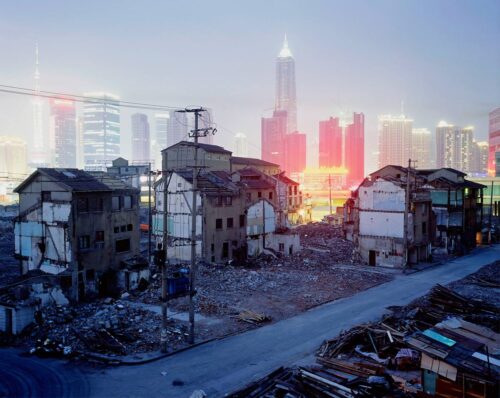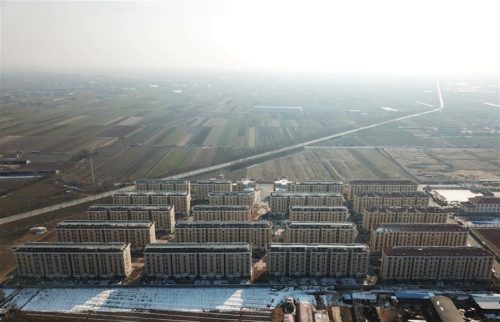In China’s countryside, housing complexes are built to be torn down
Forced relocation is an inevitability in the Chinese countryside, where apartment buildings are erected with planned obsolescence in mind. But the consequences can be deadly.

On July 7, Driver Zhang reached his limit. The 53-year-old complained of “world weariness” to his girlfriend before setting off to an early shift at work. Right before he took the driver’s seat of a bus full of nervous students en route to their gāokǎo 高考 — China’s college entrance exams — Zhang filled a plastic container with the sorghum liquor baijiu, a buffer between him and an unforgiving world.
Zhang was intoxicated as he crossed a bridge over a reservoir in Anshun, a city in Guizhou province. Suddenly jerking the wheel to the left, he swerved across five lanes of traffic and sent his vehicle plummeting into the reservoir. The public bus turned into a watery tomb, killing 21 people, Zhang included, and injuring 15 others.
Earlier that day, the driver’s home had been demolished as a result of China’s redevelopment policies — “shantytown reconstruction,” in this case — rendering him homeless.
Redevelopment campaigns have forced China’s cities and countrysides to constantly reshape themselves through a process of demolition (拆迁 chāiqiān) and reconstruction. This is one of China’s most controversial and unpopular policies, and has led to an antagonistic relationship between state and citizen. According to the estimate of Ní Yùlán 倪玉兰, a human rights advocate and victim of forced relocation, nearly half of all of China’s 100,000 yearly social protests are triggered by land disputes.
This strong pushback has failed to engender the sort of change that activists like Ni hope for. This is primarily because the unending upheaval in the housing market has made those with power very rich.
China’s houses are permanently temporary
Have you ever bought a cheap toaster that’s broken within a year? Noticed your phone slowing down after a system update? This phenomenon, known as “planned obsolescence,” is all the result of one of the more deplorable products of unregulated capitalism. In China, this problem extends to the homes people live in, and even the hotels built to treat coronavirus patients.
Planned obsolescence in construction is widespread, almost to the point of being the norm. One estimate from 2015 predicted that about 40% of China’s new developments are planned on top of demolished property.
Since buildings are constructed with their demolition in mind, they are rarely high quality. Many buildings look like they were put up during the Mao era despite being only a few years old. These concrete monstrosities are the product of perverse incentives baked into the Chinese legal system, as described by Wade Shepherd of CityMetric:
1. Local governments want to maximize tax revenue
Local governments don’t get to collect tax on property annually like in other countries. Rather, they receive a lump sum payment upon construction of a building being completed. To maximize fiscal revenue, local government officials have reason to turn a blind eye to, or even encourage, buildings that will be due for demolition in the near future.
2. The central government wants to inflate its GDP and keep people busy
The construction industry accounts for 7% of China’s overall economy. Buildings designed to last for a century don’t keep food on the table for construction workers, nor do they allow central party officials to boast of China’s meteoric GDP rise. Planned obsolescence is therefore a useful tool for maintaining social order.
3. Construction companies want to pocket funding
Bosses like to make money. By cutting a corner here or there (improperly install something, buy cheaper materials, etc.) construction company executives can line their pockets with the savings. Since everyone else stands to gain from quick and dirty construction, officials don’t ask too many questions.
What these failed policies have wrought is constant upheaval for the lǎobǎixìng 老百姓 — the common people. Local government officials seemingly have unlimited eminent domain that lets them evict and destroy at will. If residents don’t comply, utilities can be cut off, and thugs can be hired.
While evictees are “guaranteed” by law a home of equivalent floorspace or monetary compensation, this end of the deal isn’t always carried out. Many heavily indebted local governments don’t have the money to put out for new construction before buildings are due for demolition, forcing victims of this policy out onto the street, uncompensated. This is what happened to Driver Zhang hours before his murderous rampage.
How citizens are pushing back
In Chinese society, home ownership is a cornerstone of stability and pride. Perhaps that is why China’s citizens have been especially reactive to this particular infringement on their rights.
Civil resistance toward this policy is best illustrated by nail houses (钉子主 dīngzi zhǔ) that stick up like a nail in the foot of the powers that be, even if temporarily. These houses stand like the Alamo in a field of demolition, a doomed structure that nonetheless is a powerful symbol of resistance and perhaps hope.
Demolition companies have gone to extreme lengths to destroy nail houses. No method is considered too brutal — not even murder. In his book Street of Eternal Happiness, author Rob Shchmitz describes a woman who was ripped from her home and forced to watch her husband burn to death after the couple refused to vacate.
There are several weapons that homeowners employ in defense of their property:
1. Public outrage
News of nail houses and other redevelopment horror stories regularly circulate on China’s social media sites and can even make headlines on state media outlets. In 2007, a couple defending their home in Chongqing managed to capture national attention and gain concessions from their local government, such as a better deal for surrendering their home and delayed demolition time. A number of nail houses have since captured national and even international attention.
2. Violence
The threat of violence is often an effective last resort for resisting demolition crews. In his book, Schmitz describes an old man who strapped a propane tank to his chest and threatened to self-destruct in order to defend his home.
3. Legal action
Chinese citizens have filed court action against demolition authorities to varying effect. China’s courts enjoy some degree of autonomy and can be powerful engines of social change on the margins. A Cambridge study from 2018 found that in the context of demolition lawsuits, Chinese courts have been effective in constraining government abuses and extending the rights of citizens vís-a-vís Communist officials.
One could argue that civil resistance toward these policies has produced some positive change. A new code was pushed out in June that extended the power of courts and limited the rights of local officials, a move that could empower homeowners to challenge authorities more effectively. The new code is not, however, a cure for the deeper systemic issues driving these abuses that run all the way to the top of the Communist Party. The lives lost in Driver Zhang’s bus are evidence that there is still much work to be done.





